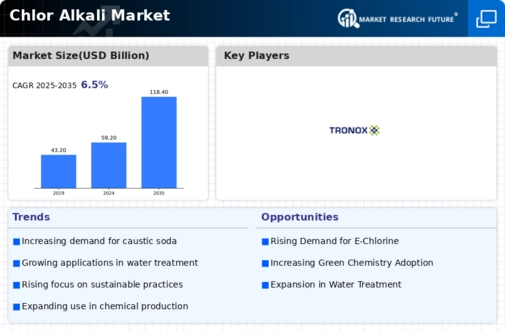Top Industry Leaders in the Chlor Alkali Market

The chlor-alkali market, a vital cog in the global chemical industry, thrives on the production of chlorine and sodium hydroxide (caustic soda) through the electrolysis of brine. Its products find applications across diverse sectors like pulp & paper, textiles, water treatment, and PVC manufacturing. But navigating this competitive landscape demands understanding the strategies at play, factors influencing market share, and the latest industry developments.
Market Share Strategies: A Balancing Act
Leading players in the chlor-alkali market employ a diverse range of strategies to secure their foothold. Vertical integration, where companies control the entire production chain from brine extraction to finished products, offers cost advantages and market stability. Dow Chemical, for instance, boasts a robust vertical setup, securing its position as a top player.
Technological advancements are another key differentiator. Companies like Olin Corporation are investing in energy-efficient membrane technology, reducing production costs and environmental impact. This resonates with the growing demand for sustainable solutions, pushing competitors to adapt.
Geographical diversification is critical in a global market. PPG Industries, with its strong presence in North America, Asia, and Europe, exemplifies this strategy. By catering to regional demands, companies mitigate risks associated with economic fluctuations in specific markets.
Acquisitions and mergers play a significant role in market consolidation. In 2022, Westlake Chemical acquired Olin's chlor-alkali assets in North America, reshaping the regional landscape. Such strategic moves enable companies to expand their reach and gain access to new resources.
Factors Shaping Market Share: A Complex Equation
Market share dynamics in the chlor-alkali industry are influenced by several factors:
- Product Demand: The demand for chlorine and caustic soda is crucial. Caustic soda, with its diverse applications, enjoys a higher and steadier demand compared to chlorine, which faces stricter environmental regulations.
- Production Costs: Energy efficiency is paramount. Companies with access to cheap energy sources and advanced technologies have a cost advantage.
- Regional Growth: Emerging economies like China and India are experiencing significant growth in chlor-alkali demand, attracting investment and shifting market dynamics.
- Environmental Regulations: Stringent regulations, especially regarding mercury emissions from traditional chlor-alkali production methods, push companies to adopt cleaner technologies.
List of Key Players in the Chlor Alkali Market:
- Solvay SA (Belgian)
- Olin Corporation (US)
- Axiall Corporation (US)
- Akzo Nobel NV (The
- The Netherlands) Bayer AG (Germany)
- Covestro AG (Germany)
- Tosoh Corporation (Japan)
- Tata Chemicals Ltd (India)
- Tronox Limited (US)
- Xinjiang Zhongtai Chemical Co. Ltd (China)
Recent Developments:
- September 2023: Solvay partners with a renewable energy provider to power its chlor-alkali plant in France, demonstrating a commitment to green operations.
- October 2023: The European Union proposes stricter regulations on mercury emissions from chlor-alkali production, pushing companies to invest in cleaner technologies.
- November 2023: A new report by a leading market research firm predicts a significant shift towards membrane-based chlor-alkali production in the next five years.
- December 2023: The global chlor-alkali market experiences a slight slowdown due to economic uncertainties, but long-term growth prospects remain positive.

